The hydrogen revolution creating a future for Southland
Murihiku Regeneration’s He Ao Hou: New Futures Murihiku is a school-based STEAM programme, focused on green energy.
The success of our programme is being recognised nationally! Read all about it below (published in the June edition of the Ministry of Education’s Education Gazette).
We would like to thank our sponsors for their ongoing support:

Professor Sally Brooker from the University of Otago’s Chemistry School, commented that the He Honoka Hauwai team is thrilled to be partnering with Murihiku on all things hydrogen. “The students are always so readily engaged, and so enthusiastic, in learning about these future renewable fuels and careers, and this rubs off on us!”
The hydrogen revolution creating a future for Southland
By Education Gazette Editors
Issue: Volume 103, Number 8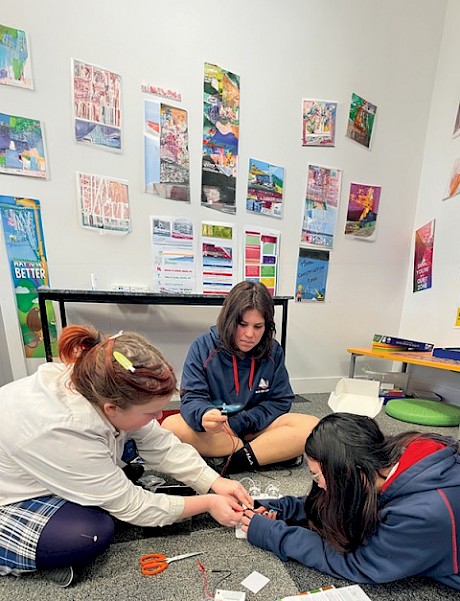 The hydrogen kits create enough energy from water to run a fan.
The hydrogen kits create enough energy from water to run a fan.
A science programme in Southland is teaching ākonga about the power of hydrogen in an initiative developed to build the skills and expertise needed in future generations.
At Waiau Area School in Southland, ākonga in Years 7–10 are setting up hydrogen fuel kits. Using battery packs, they’ll create enough hydrogen from water to run a fan.
The school’s science teacher, Florence Chatelier, says the hydrogen fuel kits have helped ākonga understand the potential of renewable energy.
“It’s led to discussions about how to reduce climate change and the future of green energy. The kits also include coloured cellophane that lets students explore the light spectrum and compare how different colours impact the energy going from the solar panel to a fan,” says Florence.
It’s part of an outreach programme developed to teach ākonga to make hydrogen and to understand its potential as a green fuel, even using it to power toy cars.
The programme’s Dr David Warren says students constantly surprise him with their enthusiasm.
“We show them how to put the kit together themselves and they can see the hydrogen being made. Then they connect the motor up and see it move. They’re pretty astonished to know they’ve made the hydrogen themselves and they understand why it’s working and why it’s so cool. That excitement is magic to see.
“Some of the students are from farms and with that background, they think about using hydrogen in the context of a farm operation,” says David.
Skills and expertise for science industries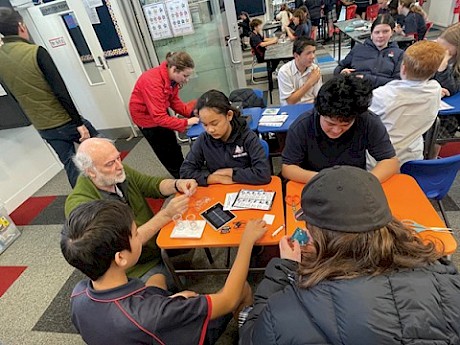 The programme encourages ākonga to develop the skills and expertise for a future workforce.
The programme encourages ākonga to develop the skills and expertise for a future workforce.
Otago University’s School of Chemistry’s outreach programme has been visiting schools in the South Island for a number of years, inspiring students to think about science and its role in society.
In 2022, David and a group of PhD students teamed up with Murihiku Regeneration, an initiative focused on creating jobs for Southlanders in the event the Tiwai Point aluminium smelter closes. It encourages ākonga to develop the skills and expertise to become part of the workforce for those industries.
Together they have taken the hydrogen programme to 25 of Southland’s 63 primary schools.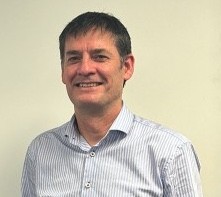 Ivan Hodgetts is a leading careers expert, and the driving force behind the project.
Ivan Hodgetts is a leading careers expert, and the driving force behind the project.
Murihiku Regeneration is led by Ivan Hodgetts, who says the initiative is a deliberate attempt to disrupt the intergenerational assumptions tamariki and rangitahi are used to making about their career options. (Read more about Murihiku Regeneration’s Te Ara Aukati Kore - education, training, and capability)
“The reality is that the under-30 workforce for those organisations – the power generators, companies and manufacturers of 2035 – are in our schools, learning, right now.
“We have built a vocation transitions framework so that whether the smelter closed or not, there are already emerging industries and a skilled workforce. Some of the jobs they’ll be doing already exist and others will be designed to fit emerging technologies.
“The trick here is to do this work in a way that doesn’t try to pre-determine an emergent future and force people into ‘pipelines’. Ultimately, we don’t fully know where technology and human creativity will take us, but we can be prepared,” says Ivan.
Sparking curiosity and starting conversations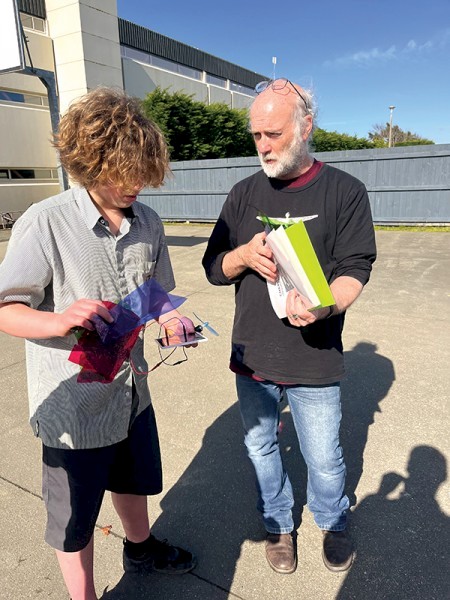 Dr David Warren (right) has been inspiring students to think about science and its role in society for years.
Dr David Warren (right) has been inspiring students to think about science and its role in society for years.
Waiau Area School associate principal Richard Bennett says ākonga were enthused by the visit from Dr Warren and his students last year.
“It has really engaged our ākonga. It sparked their curiosity and started conversations about how it was happening and what could be possible in the future.
“We want to inspire them to think about their place in that future and the roles that are needed to build industries in this region. It’s unusual to have scientists come to your primary school and teach,” he says.
“All they have to do is turn up and be willing to learn,” says David. “We hope that by taking the science to them and teaching them to make hydrogen, they’ll start thinking up different ways they can use science to make things they want.”
Ivan says the programme uses hydrogen because it’s a great way to show how green energy can work.
“We’re thinking about where the hope and purpose is for these ākonga. By demystifying science, we’re showing them that technology is changing fast and they can be part of that in lots of different ways.
“Their future isn’t necessarily in hydrogen. They might end up doing something else entirely, but hydrogen is a good way to teach sustainability because it’s a green fuel.”
Dreaming big dreams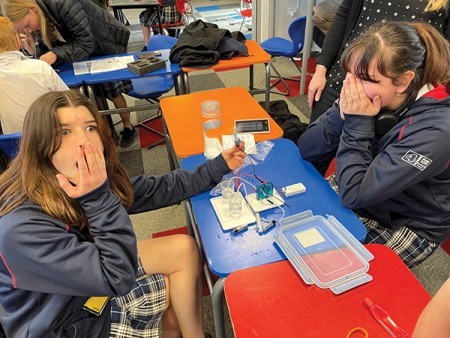 Students are often astonished to know they’ve made hydrogen.
Students are often astonished to know they’ve made hydrogen.
David says the university students love going out to the schools.
“They’re closer in age to the ākonga than I am. It’s our hope that making cool science experiments with those young learners will help them imagine a similar career for themselves.
“We want these ākonga to broaden their aspirations and we hope many of them will choose to study science. It’s about inspiring them to dream some really big dreams for themselves and to know how they can make them become reality.”
Ivan says he hopes Murihiku Regeneration will become a more systemic way for ākonga to experience 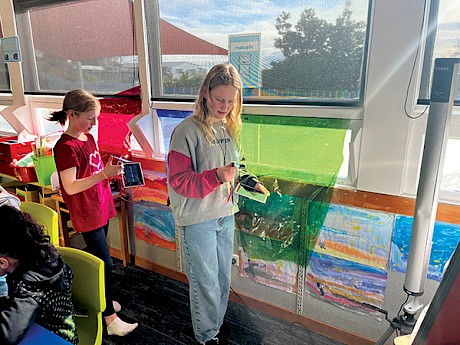 Coloured cellophane lets ākonga explore the light spectrum and compare how different colours impact energy.magic moments of inspiration.
Coloured cellophane lets ākonga explore the light spectrum and compare how different colours impact energy.magic moments of inspiration.
David agrees. “I like to tell them about the story of Professor Alan McDiarmid. Professor McDiarmid won the Nobel Prize for Chemistry, but very nearly didn’t get into science at all.”
As a student, McDiarmid showed an interest in science, but it wasn’t until he was in his last year of high school that his passion for chemistry ignited. He went on to complete two PhDs, eventually becoming a joint winner of the 2001 Nobel Prize in Chemistry for his part in the discovery of a plastic polymer that could conduct electricity.
Breaking down barriers
Murihiku Regeneration is just beginning its next series of school visits to Southland schools. The team will visit some schools multiple times, bringing different science ideas to inspire the next generation as well as holding teacher professional development days to support STEAM education in Southland’s schools.
Ivan says the project is breaking down what he calls the ‘expert’ barrier – giving teachers access to the expertise to create STEAM experiences and broaden their own capability to teach STEAM subjects.
“We hope these students will become the many different kinds of engineers and managers and IT architects and other roles we can’t even imagine, yet who will build the future industries of Southland.”
What the students said
“It was amazing to see energy produced from water. I didn’t know that was a thing.” Deakon, Year 9
“I liked being able to follow the instructions to build the fuel cell and then to see the fan start to move was awesome.” Hamiora, Year 7
“It was so cool. It made us think about how it can benefit us in the future, it is much more environmentally friendly to get power from hydrogen or solar. Why don’t we have solar panels at our kura?” Summer, Year 10
“My eyes were opened to the potential of future energy production.” Maddi, Year 10
Posted: 5 July 2024
